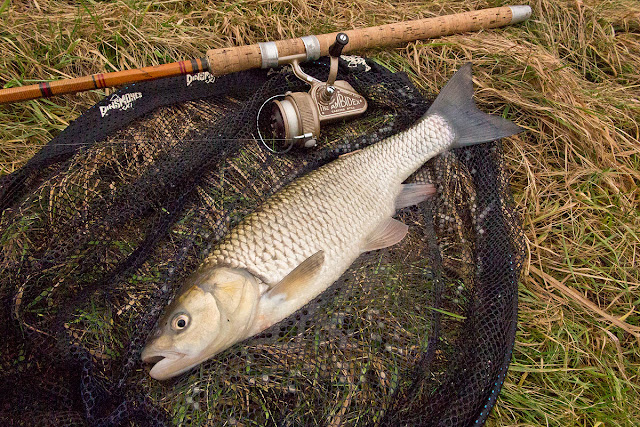I'VE GOT THE POWER....GUM
In a bid to set the hook on more of the smaller bites that I have been getting on the Leam, I have been looking at some of the so called self hooking rigs that matchmen use. Basically these have been either running rigs with a check of some kind that comes into effect after the fish has taken two or three inches of line, or paternosters that in effect allow similar leeway according the length of the lead link. The idea is that the fish moves off with the bait and is pricked when the rig runs out of slack.
I don't really see how this works, because both systems are tight to the rod tip, so there is no leeway before the fish feels resistance. Small fish don't inhale baits and move off in the same way as, for example, carp or barbel do. More likely, they will suck in and blow out a bait without turning away. Not only that, they don't necessarily take it past their lips until they are truly happy that there is no unnatural resistance. Subsequent striking then only serves to whip the hook away before it is inside the mouth.
Most of the time the angler is using a quivertip but far from allowing minimal resistance, the tip is bent right round against the lead negating most of its sensitivity. All of these rigs have one thing in common however and that is the inclusion of power or feeder gum in the hooklength. I believe that this is employed to cushion a finer hooklength than usual but I have a sneaking feeling that, more importantly, it actually cushions the more stubborn resistance of the rod tip.
To that end I am using a helicopter rig at the moment which gives me an infinitely variable paternoster link. The revolving swivel has an inbuilt link and rubber shroud to enable easy connection of the hooklink. I've started with eighteen inches of feeder gum with another six inches of fluorocarbon on the end with a size 14 hook attached. That is big enough to carry a piece of flake the size of a ten pence piece and small enough to carry a single piece of 6mm punch.
The first swim produced some small fish interest in the form of one rattle and a hooked and lost dace before a more confident bite found me attached to a hard fighting chub of 2-13. In an early departure from my two swim plan, instead of persevering for two hours, I moved on after one and dropped into a swim in the wood that has produced smaller fish in the past. It did today as well, I had a couple of indications that I never struck at before catching a small roach. The fish never seem to get their heads down on this river and as usual after catching one, no more bites were forthcoming. Large or small, one fish kills the swim so I set off for the second targeted swim of the day.
Things went pretty well there with, once more, a single firm bite producing a 2-15 chub, before I moved another fifteen yards downstream and caught my last at two pounds exactly. The one fish per swim, no matter how many bites precede it appears to be the first rule of fishing this river, but at least I am making progress in my quest to make small bites more hittable.
It's early days, but I had four small bites today and hooked two of them which is a big improvement if not exactly spectacular. I also had three nice easy hits catching three nice chub on this rig so I have nothing to complain about. If I had to put my finger just what the improvement is, I would suggest that it is in the elasticity of the gum and the fact that I pull two or three inches of line from the reel rather than having it bowstring tight to the tip. It will make drop backs harder to spot if one can't see the line but does allow some low resistance movement away from the tip. The longish hooklength also allows free movement in most directions, evidence of which has been the serious need for a disgorger on two of the three chub caught so far. The hook was out of sight on each occasion but easily removed for all that.
Only one of those chub bites pulled the tip round, the other two were just firm plucks, another sign I believe that the rig does not startle a taking fish so much. Whether that is a good thing or not only time will tell.





Comments
Post a Comment